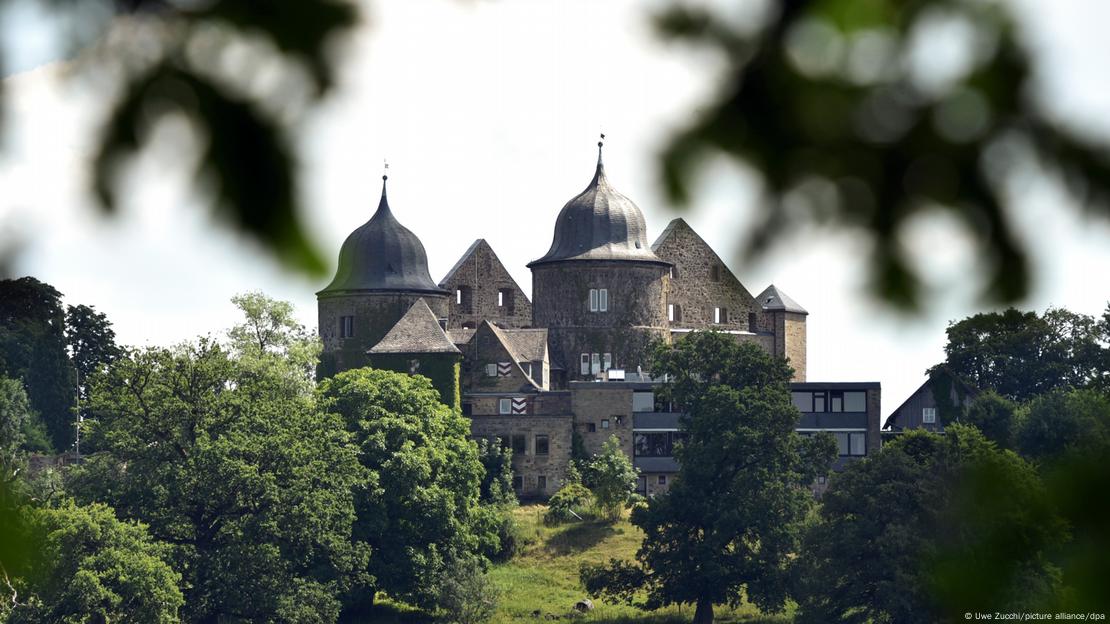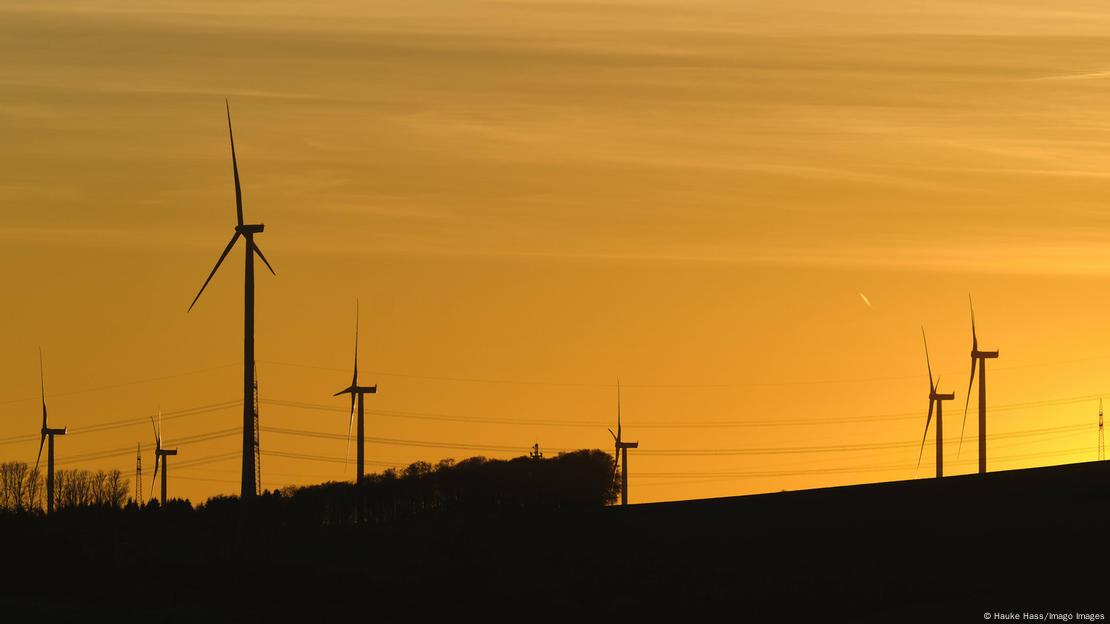Kristie Pladson
Germany is counting on wind energy to help replace fossil fuels. But critics say massive investment in the sector is ignoring a different environmental crisis.
They call it the "Sleeping Beauty Castle." Sitting on a hill in the middle of the Reinhardswald, an ancient forest said to be the inspiration for many of the fairy tales written by the Brothers Grimm, the Sababurg is a lovely 14th century castle known for its magnificent rose garden and towers.
But we're not here to see Sleeping Beauty or her castle in the central German state of Hesse. In fact, we're standing with our backs turned to it. Ralf Paschold, a wind energy entrepreneur, points at a tree-covered ridge off in the distance.
"For the next 30 years," he said, "I will produce energy there."

Some locals argue wind turbines would ruin the view from "Sleeping Beauty Castle" in Hessen, Germany
Image: Uwe Zucchi/picture alliance/dpa
Four to five wind turbines a day
Paschold, who is from the area himself, has built wind farms in Canada, France and other parts of Germany. Now he plans to build 18 wind turbines here in the Reinhardswald. Overall, the forest is 20,000 hectares, but Paschold only wants to use 14 hectares where drought and a beetle infestation have killed the trees for his turbines.
His business venture is one small part in Germany's vast plan to awaken its domestic wind energy sector from slumber. Germany is already big on wind: with nearly 30,000 onshore wind turbines, the country trails only the US and China.
But it's not enough to meet the country's climate goals. Today, only 0.8% of Germany's land area is approved for onshore wind energy. By 2032, the government wants to have 2% of land area allocated for onshore wind power. This means installing between 1,000 and 1,500 new turbines a year, or four to five a day by 2030, as German Chancellor Olaf Scholz recently said.
Germany needs wind energy to meet its goal of becoming carbon neutral by 2045, a target it's currently in danger of missing, according to multiple studies. The country also missed its emissions reduction targets the last two years in a row, according to think tank Agora Energiewende.
"If Germany fails to meet its climate targets, we will not be able to demand that others meet theirs," Germany's Economy and Climate Minister Robert Habeck said in February.

To meet its 2030 climate goals, Germany should be installing 4 to 5 wind turbines a day
Image: Hauke Hass/Imago Images
Local resistance and red tape
Between its domestic goals and an international reputation as a leader in sustainability, an outsider might be surprised to learn how hard it is to build a wind turbine in Germany.
"Just the time to get the permit takes two and a half years," Paschold said. "Why? Because the process is too difficult."
German states are responsible for proposing spaces of land where wind turbines can be built. But these decisions are often met with fierce resistance from locals, who have a wide range of problems with having wind turbines installed close to home, including fear of health risks or ruining the view of cultural sites, like Sababurg castle.
Complicated regulations, a lack of government workers to process the paperwork, and efforts to keep wind turbines away from animals' natural habitats are also preventing the sector from developing as the government wants, Paschold says.
"The dormouse, the bats, the birds, the small salamander," he said, listing local animals, "I will protect them. Because my heart is beating for them. But we can bring all these things together. It's easy."

Europe's energy pricing system means wind turbines generate a lot of revenue relative to production costs
Image: Hauke Hass/Imago Images
Disturbing protected ecosystems
But the energy entrepreneur knows how difficult this is in reality. His own project is currently on hold while a court tries to determine whether constructing wind turbines in the Reinhardswald poses too great of a risk to the forest's dormouse population.
In a nearby corner of the Reinhardswald, where one of Paschold's turbines is meant to be built, is Annette Müller-Zietzke, an occupational therapist and member of the campaign "Save the Reinhardswald." The group aims to keep wind turbines out of the forest. At the site, she points out how new beech trees have started springing up between the tree stumps. Among the stumps and shrubs is where the dormouse likes to hide, she tells DW.
"Legally, this area is forest as long as all of this is here," she said. In a protected forest like this, you aren't even allowed to pitch a tent because of the risk it poses to the habitat of the animals living there, she points out.
No human would willingly choose to live directly under a wind turbine, adds Müller-Zietzke.
"And then, for these species that are even more sensitive than we are, we just say, 'It probably doesn't matter.' In times of probably the greatest loss of biodiversity since the extinction of the dinosaurs, this is a terrible, fatal development."

Germany trails only China and the US in energy generation from onshore wind turbines
Image: Ina Fassbender/AFP/Getty Images
Big money for wind farmers
The conservationist says that because of her anti-wind views, people often lump her together with rightwing parties, like the far-right Alternatives for Germany (AfD), that are critical of renewable energy.
She rejects this affiliation completely. But she's concerned that other critical environmental issues are being sacrificed in order to hit the country's ambitious wind targets.
Especially if there is money to be made. The system for pricing electricity in Europe, known as the merit order system, means that energy that is relatively cheap to produce, like wind and solar, is sold at the same market price as the most expensive sources of energy. When oil and natural gas prices skyrocketed after Russia invaded Ukraine, the price of electricity generated from wind went up as well.
"It's not the target of the wind farmers to earn this difference with the gas price," said Paschold. "But yes, it's an effect of the system."
Government sides with wind sector
The lengthy licensing process, long construction times, and issues with supply chains and inflation are still taking a big bite out of wind parks' profit margins. But with a government mandate to see through the transition to green energy, it can seem like a sure bet in the long term for those willing to invest, even with the hurdles.
Frustrated activists seem to see it this way, too.
"How can it be that we put giant turbines … in such a highly complex ecosystem, which suddenly doesn't seem so complex anymore if we're talking about putting a windmill there?" Müller-Zietzke asked.
Paschold thinks building in the forest is justified under the circumstances. "We have the Earth heating. We have all the problems. We need more and more power. We want to have cars powered by electricity."
So build them, he says, and see what happens in 30 years.
"Perhaps, by then, we have a better idea than producing energy with wind turbines," said Paschold. "And if we have a better idea, I can take them down in a few days."
Natalie Muller contributed to this report.
Edited by: Tim Rooks
No comments:
Post a Comment